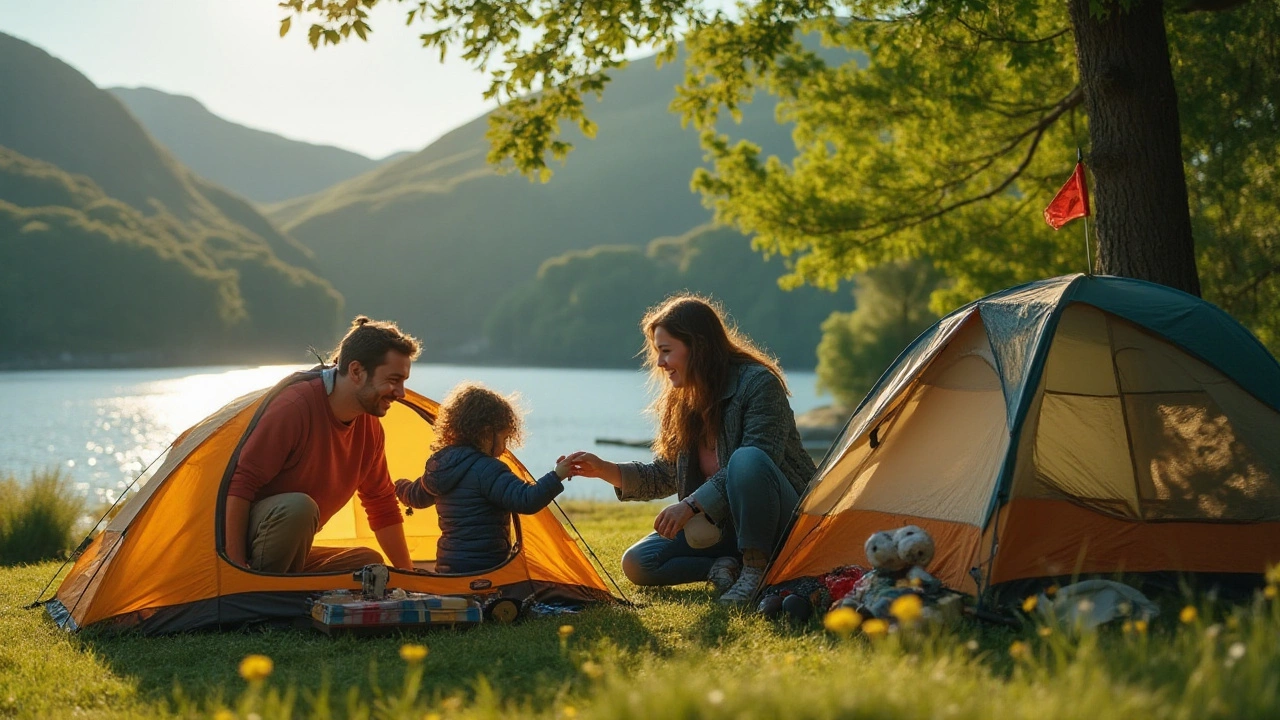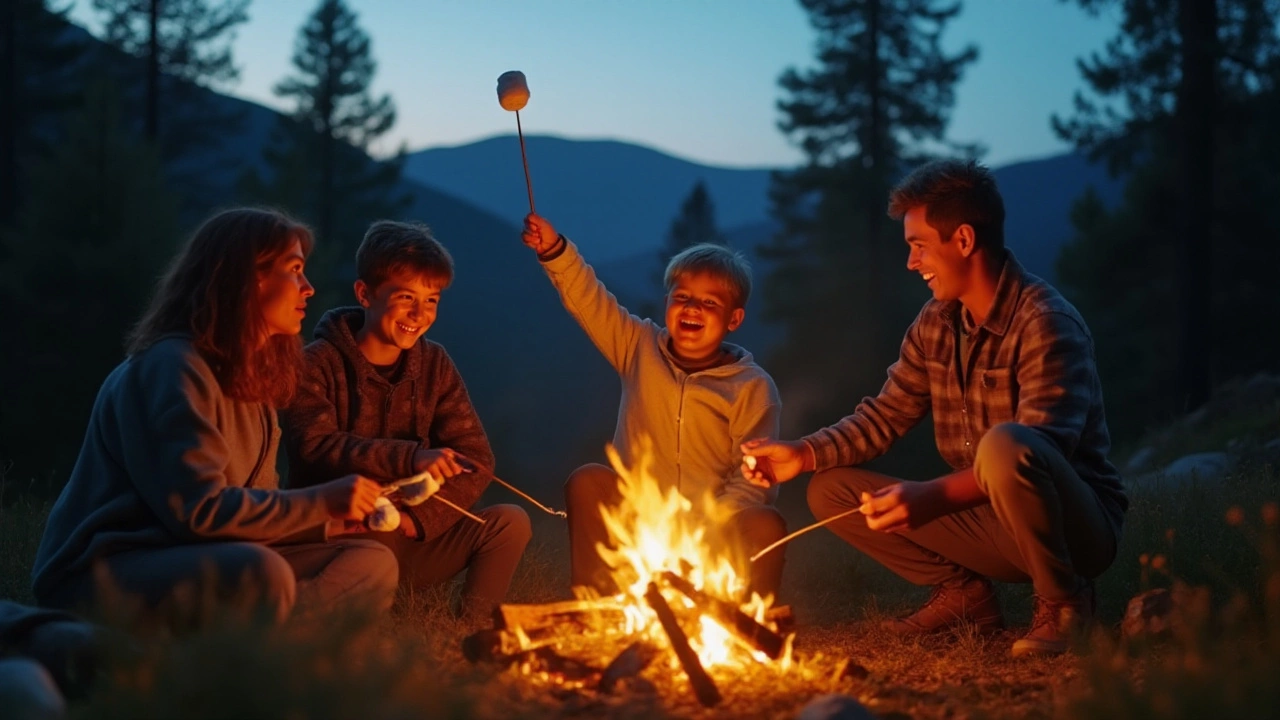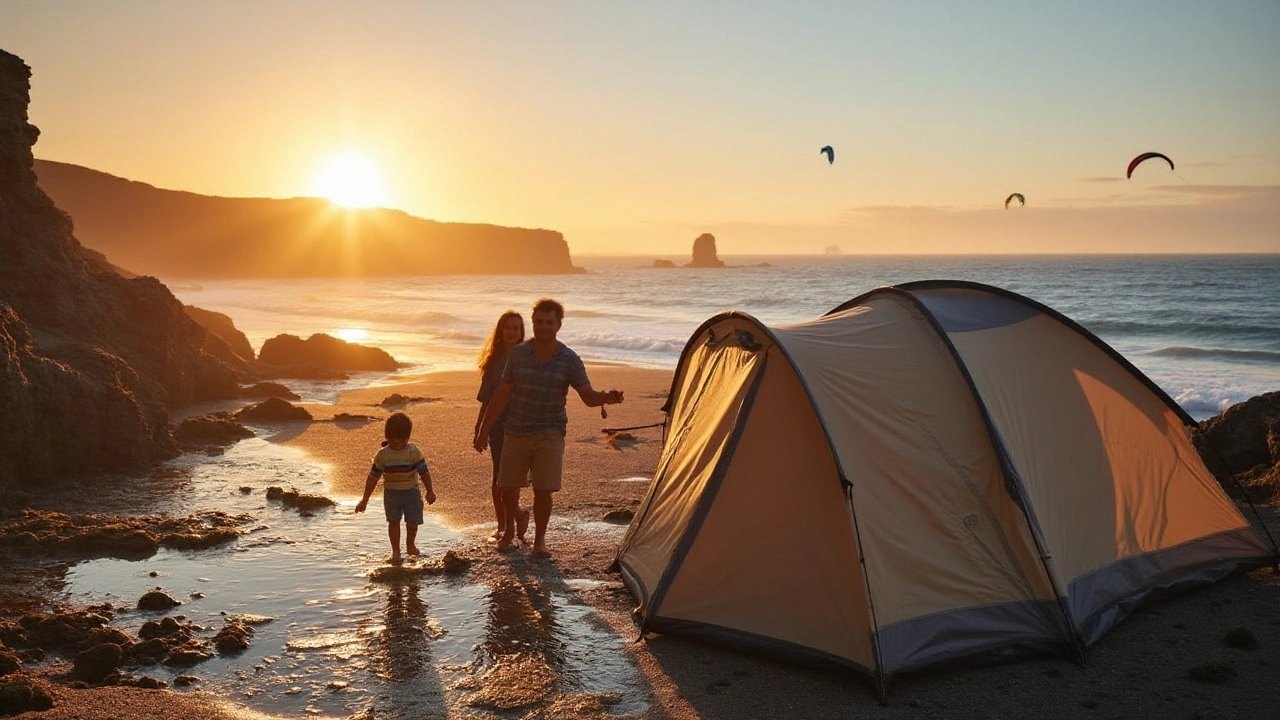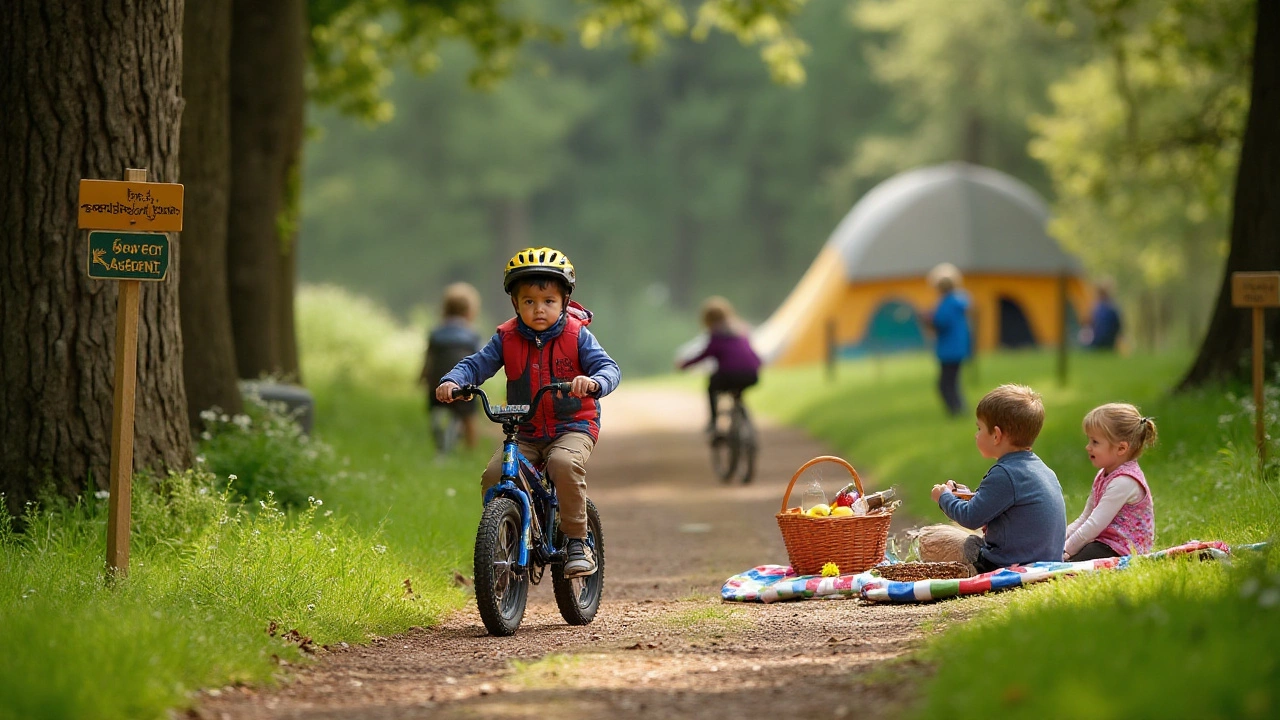Camping Adventures with Your 5-Year-Old: Tips and Insights
 Oct, 27 2024
Oct, 27 2024
Camping with a young child can be one of the most enriching experiences you share as a family. It's the perfect chance to escape from the daily grind and immerse yourself in nature while instilling a love for the outdoors in your little one. A five-year-old is at a prime age to explore, learn, and have fun, making camping an ideal adventure for growth and bonding.
As you prepare for this exciting endeavor, you might have questions about where to camp, what to bring, and how to keep your child safe and entertained. The right guidance can transform your camping trip into a seamless adventure. With some thought and preparation, you and your family can enjoy all that camping has to offer, creating memories that will last a lifetime.
- Choosing the Right Campsite
- Essential Gear and Packing
- Fun Activities for Kids
- Safety Tips and Precautions
Choosing the Right Campsite
When it comes to embarking on a camping adventure with your five-year-old, selecting the appropriate campsite forms the cornerstone of a successful trip. A child-friendly campsite can make all the difference in ensuring both safety and enjoyment for your little ones. The first step is to identify campsites that are known for welcoming families with children. Many national parks and private campgrounds offer specific facilities and activities designed to engage young adventurers. Look for amenities such as playgrounds, nature trails, and bodies of water that are safe for wading. Such features not only enhance the excitement for children but also provide an array of activities to keep them fascinated and occupied during your stay.
Another key factor to consider is the proximity of the campsite to your home, especially if it's one of your first camping trips. Choosing a location within a reasonable driving distance can prevent the stress of a long journey, which might lead to restlessness in children. It's a good idea to select a campsite that provides access to clean restrooms and potable water, especially important for families with young kids, as these basic facilities add convenience and comfort to the camping experience. Additionally, evaluate the ground surface where you'll be pitching your tent; ideally, the site should have flat and stable ground to ensure a comfortable sleeping surface for your child. A peaceful and sheltered area can also provide protection from harsh weather conditions, making your camping trip more pleasant.
Researching the local wildlife and plant life is another important aspect to consider. Understanding the type of environment you'll be bringing your five-year-old into will allow you to anticipate potential hazards like poison ivy or insects and prepare accordingly. Knowing the typical climate and landscape can also help inform appropriate clothing and gear choices. To further engage your child, try involving them in the planning process. Show them pictures and maps of the site, and encourage them to choose areas they would like to explore. This creates a sense of adventure and ownership over the trip, enhancing their overall experience.
According to the American Camp Association, camps that incorporate family-friendly elements can significantly improve children's social skills and outdoor knowledge, which reinforces the importance of choosing the right site for your camping adventure.
A well-chosen campsite can transform your experience from mundane to magical. Collaborate with other experienced camping families, or look for online communities and forums where parents share their personal recommendations based on firsthand experiences. Some campsites even offer family-specific events and workshops in the summertime, adding an educational component that can enrich your child’s nature-based learning. Ultimately, the goal is to create a safe and stimulating environment where every member of the family feels comfortable, allowing for a harmonious blend of relaxation and exploration.

Essential Gear and Packing
Packing for a camping trip with a young child involves a delicate balance between being prepared and not overpacking. It's crucial to bring the right items to ensure both comfort and safety while keeping the load manageable. When embarking on an adventure with your 5-year-old, tap into the spirit of discovery and pack gear that stirs curiosity while keeping them secure. A good starting point is to focus on the essentials like a family-friendly tent, suitable sleeping bags, and proper clothing.
First, consider the family camping tent. Choosing a tent that offers enough space for everyone to sleep comfortably can make a significant difference. Look for a tent with features such as quick assembly, ventilation, and a robust rainfly. This way, you avoid getting caught unprepared by sudden weather changes. An inflatable mattress or sleeping pad, paired with a cozy sleeping bag, will ensure a good night's sleep after a day full of adventures.
When it comes to keeping your little one cozy, layering is key. Weather can be unpredictable, especially in more remote camping spots. Pack clothes that can be layered and adjusted according to the temperature. Ensure your child has a lightweight jacket, a warm hoodie, and breathable, quick-drying shirts and pants. Investing in quality gear like waterproof shoes and a sun hat can also make all the difference. Don’t forget about the little things like socks and underwear, as having extras can be very handy.
Safety and Convenience
Safety is paramount, so a first-aid kit tailored for children should be high on your list. Consider allergies, sensitive skin, and common childhood ailments when loading it with items. Pack antiseptic wipes, bandages, cold medicine, and an emergency whistle. A compact flashlight with extra batteries is also a must for after-dark includes and to soothe any nighttime fears. Bug spray and sunscreen formulated for kids will help protect against the elements. “Parents should always prioritize their child’s safety and comfort,” advises the American Academy of Pediatrics. “In the wilderness, it’s essential to equip children with foundational outdoor skills and essentials.”
Alongside essential safety gear, think about convenience. A sturdy backpack for your 5-year-old can help them develop responsibility and take pride in carrying their own water bottle, snacks, and a favorite toy. Binoculars can turn a simple walk into an adventurous expedition, encouraging exploration and learning. Remember to pack a child-friendly camera or a small journal where they can record their impressions, creating a keepsake of the trip and fostering a sense of wonder.
Camping Cuisine
Food plays a pivotal role in the camping experience. Engage your child by planning meals that are both fun and nutritious. Having a portable grill or camping stove at your disposal opens the door to various meal options ranging from grilling proportions to simmering soups. Bring along foods that are easy to prepare and don’t require refrigeration such as instant noodles, oatmeal, and canned beans, but don’t shy away from those classic camping favorites like marshmallows for s’mores. “Anyone can cook, but few savor the culinary delight of outdoor dining. It's primal—humans around a fire, sharing meals under the stars,” chef John Doe once remarked. Involve your child in simple cooking tasks to make them feel part of the process while teaching valuable skills.
Packing efficiently and wisely for a camping trip with a youngster can transform the experience from a daunting challenge into an enjoyable adventure. With these essentials and a little foresight, you ensure your child experiences the wonder of outdoor adventures while building memories that will last a lifetime.

Fun Activities for Kids
When it comes to camping with a 5-year-old, the key to a successful trip lies in keeping your young adventurer engaged and excited. Nature offers a treasure trove of fun activities that are not only entertaining but also educational. One timeless activity is a scavenger hunt. Little ones love the thrill of finding hidden objects, and a ready-made list of easy-to-find items like pinecones, different leaf types, or animal tracks can keep a child occupied for hours. Make it a game and offer a small prize to stir up a healthy bit of competition among siblings.
A camping trip also presents the ideal backdrop for stargazing. With the right weather and a clear sky, your child can learn the basics of identifying constellations. Bring along a simple star chart to help guide the way. Use this opportunity to talk about the myths and stories related to the stars. It's a great storytelling moment that also teaches astronomy. According to a study by the University of Edinburgh, children who partake in outdoor stargazing show improved memory and cognitive skills.
"An early immersion into astronomy not only fascinates children but ignites a lifelong passion for the sciences," say researchers at the Observatory Science Centre.
Of course, not everything has to be educational; sometimes simple fun is enough. Campfire songs and stories are a perennial favorite. Prepare a couple of age-appropriate ghost stories that will excite without frightening. Encourage your child to come up with their own stories, too. A child's imagination is boundless, and they'll delight in seeing their ideas come to life around a campfire.
For daytime joy, bring along a kite. Open spaces and clear skies make for ideal kite-flying conditions, and it's a simple pleasure that many children adore. If kites aren't your thing, consider creating a small obstacle course using items from nature. Rocks, logs, and trees can serve as the perfect environment for a child who needs to expend some energy. This not only keeps them active, but also helps develop their motor skills.
| Activity | Time Needed | Skills Developed |
|---|---|---|
| Scavenger Hunt | 1-2 hours | Problem-solving, Observation |
| Stargazing | 1 hour | Learning, Astronomy |
| Kite Flying | 30 minutes to 1 hour | Coordination, Aerodynamics |
| Obstacle Course | 30 minutes | Gross Motor Skills |
To round out the day, crafting with natural materials found on-site can be a quiet yet rewarding way to conclude an action-packed day. Gather twigs, leaves, and stones to build small models or pictures as mementos of the trip. Providing paints or markers can add an element of personalization. These creations serve as both a keepsake and a visual story to share with friends and family once you’re back home.

Safety Tips and Precautions
Camping with a child can feel like a balancing act of keeping things fun while ensuring everyone stays safe. Young children, like a 5-year-old, often see the world as a playground. For an enriching and secure outdoor adventure, thinking ahead and setting some ground rules can make all the difference. First and foremost, keep an eye on the terrain and weather conditions of your chosen family camping site. Check forecasts and understand local wildlife; these factors are crucial to plan the right clothing and gear. Weather can change unexpectedly, especially in more remote areas, so packing versatile clothing layers is always a wise decision.
Establishing some rules with your child before setting out can be helpful. Discuss the importance of boundaries and why they should always stay within sight. Children are naturally curious, so you can turn this into a learning experience. Have a system, like a whistle or a bell, for them to signal if they need help or feel uneasy. Teaching them a few basic survival skills can also boost their confidence and make the experience more interactive. According to the American Academy of Pediatrics, children at this age can grasp simple instructions when communicated clearly and consistently.
It's equally important to prepare a robust first-aid kit tailored for outdoor activities. Your kit should include basics such as band-aids, antiseptic wipes, and insect bite cream. When camping, extra emphasis should be placed on tick prevention; tick-borne diseases can have serious implications, and ticks are often found in wooded or grassy areas. You may need to conduct daily tick checks on everyone, including your pet, if one is accompanying you on this camping trip.
Maintaining proper hydration and nutrition also plays a significant role in safety when camping with kids. Children are more prone to dehydration than adults, so pack plenty of water and healthy snacks. Teaching them the importance of staying hydrated, especially under the sun, is a lesson that will benefit them for years to come. Make use of reusable water bottles and keep them filled. Planning meals that are easy to prepare and balanced ensures the entire family is energized and happy throughout the adventure.
“The nature of camping in family-friendly environments shines a spotlight on safety and enjoyment, maximizing the experience for every member,” says Dr. John Hamilton, a renowned pediatrician and camping enthusiast. “Helping your child understand and respect nature's boundaries preserves both their safety and the environment.”
Lastly, don't forget about fire safety protocols. Whether you plan to have a bonfire for roasting marshmallows or simply using a camp stove, children should always be at a safe distance and supervised. Demonstrating what not to do can sometimes be as effective as showing them the right way, especially with something as fascinating as fire. These practical tips can pave the way for a memorable and secure outdoor adventure that you're bound to reminisce about fondly.